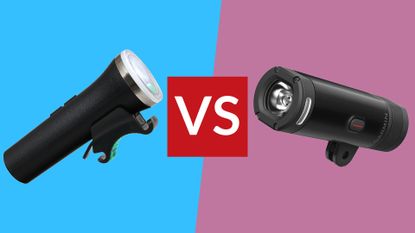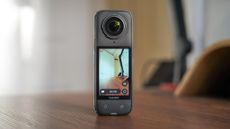The Beryl Laserlight Core and Garmin Varia UT800 front bicycle headlights both offer some kind of smart feature, be it the ability to beam a laser bike path a few metres ahead or automatically adjustable lumen output depending on speed, but which one is worthy of your attention and, more importantly, cash?
Both of these smart headlights are among the best bike lights available, at least if you want some thing more complicated than the usual front light fare. So I've gtried them in rain, shine and gloom (well, it is summer) to see how they stack up and whether their individual fancy features are actually beneficial or just a bit of a gimmick.
Both the Beryl Laserlight Core and the Garmin Varia UT800 boast in excess of 400 lumen of light power, with the Garmin projecting a steady beam of 800 lumens, which makes it visible from more than a mile away.
That said, the Beryl Laserlight also has the benefit of a frickin’ laser attached to it that projects a bright green image ahead of the bike so fellow road users can see you before you’ve even arrived. See, both smart and both quite expensive, so which one is worthy of your hard earned dosh?
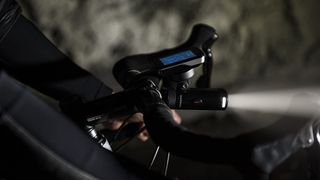
Beryl Laserlight Core versus Garmin Varia UT800: design and build quality
Let’s start with the Beryl Laserlight, which unlike its more premium Laserlight sibling, isn't fashioned from premium ‘aircraft-grade’ aluminium. Here, you'll have to make do with a reinforced polymer and at 106mm long, it also feels a bit like a small torch when attached to the bars.
The overall design is slick though, and operation is via two really simple buttons on the top of the light. Switching on either the light or the laser image is as simple as pressing the corresponding button.
Both the laser light and the white light have a number of modes (simply press the corresponding button again to scroll through), although you only get the option of solid or flash when it comes to the green laser image, while the solid white light has a flash function, as well as a high or low function on the solid beam.
The Garmin Varia UT800 Smart Headlight is slightly smaller at around 96mm in length and is predominately made from plastic with chunky rubberised protective elements.
It is smarter than the Beryl in so much as it can be synched with a Garmin Edge bicycle computer to base its lumen output on speed, as well as the ambient lighting conditions. It’s a clever piece of kit that can be either controlled manually via the buttons or through an Edge computer. Opt for the former and you can cycle through five light modes, including the most powerful 800 lumen blast and a day flash.
Of course, Garmin's lamp fits nicely to one of its “out-front” cycling computer mounts, but there’s also a friction mount so you can pretend to be a miner with it on top of your helmet. Although we disagree with the safety implications here, because bulky things mounted to helmets have never proved helpful in a crash situation.
The more expensive Beryl Laserlight comes with its own Mount, which is essentially a steel hoop (Marine grade, of course) that loops around the bars and tightens with an Allen key. But here, you get a plastic base and a rubber band to throw around the bars.
The Beryl’s quick release mechanism involves a small lever underneath the light itself, but this is more fiddly than it needs to be. A quick quarter turn of the Garmin model is much easier in practice.
- You will also need one of the best rear bike lights as well, of course
- Now add a slick pair of the best cycling shoes to your wardrobe
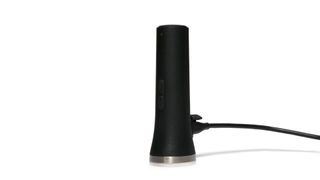
Beryl Laserlight versus Garmin Varia UT800: performance
If we are purely judging these lights on how bright they are, the Garmin Varia UT800 wins hands down. After all, 800 lumens trumps 300 all day long and in reality, 800 lumens is plenty enough to light up even the darkest of country roads in the dead of night.
The Beryl Laserlight packs half the lumens and it doesn’t project as far or as wide as the Garmin model. That said, it’s perfectly good enough for inner city use, where ambient light is generally better. Cheers light pollution!
The laser light is also a funky idea and anyone who has thrashed around London on one of the Santander bikes (nee Boris Bikes) will have seen the tech in action. It projects a small green bike icon on the road ahead and essentially creates a moving bike path so fellow road users see you coming and, hopefully, give you a bit of space.
It works well once the light is set up properly, but bear in mind its position on the bars will determine how large or small the icon is on the road ahead. This takes a bit of trial and error.
The laser itself is extremely bright and clearly shows up on the road or path, even under bright street lights. However, I found the length of the Beryl Laserlight Core and the way it is mounted to the bars meant it was quite easy to accidentally knock out of position, which screwed up the green laser projection.
Both lights boast an impressive battery life, with Garmin stating 41 hours in Day Flash mode (without laser) and 1.5-hours on the maximum output (with laser), while the Beryl manages 29 hours with a flashing front LED or two hours with both the laser and the LED on its highest setting.
After testing both together over several weeks, the Beryl came out on top for battery life, as it proved plenty bright enough on a low LED setting with a constant laser and often didn’t need charging for an entire week of short commutes.
The Garmin, due to the fact that I used it when paired to an Edge computer, seemed to run dry a bit quicker, but due to its powerful output, it could easily be dropped to its lowest setting while remaining perfectly bright enough for an around-town blast.
Both are easily charged via USB cables, although the Beryl charges to 50% in an hour, which is plenty enough to see you home after a quick charge at work, for example.
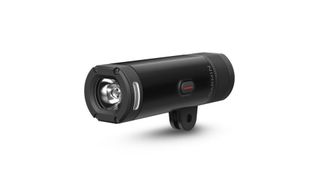
Beryl Laserlight versus Garmin Varia UT800: verdict
It’s a close call, because both lights are very good and pack some interesting features. The Garmin feels better geared up to serious road cyclists who perhaps want to carry on their training well into the autumn and winter months and it’s innovative ambient light sensing abilities mean there is little need to have to interact with it once installed.
The Beryl Laserlight Core is a nice piece of design but it is quite long and I personally didn’t like the way it sat perched on top of my handlebars. It was just too big and bulky, leading to me accidentally knocking it out of place on a couple of occasions.
On top of this, it’s difficult not to feel like a bit of a dork with a big green big laser logo shooting out in front of you. There’s no denying it catches the attention of careless motorists, but if white van drivers needed more of an excuse to hurl abuse out of a window, they just got one.
Conclusion: for an intensely bright projection and innovative light and speed-sensing features, it’s worth digging a little deeper into the pockets and opting for the Garmin Varia UT800.
